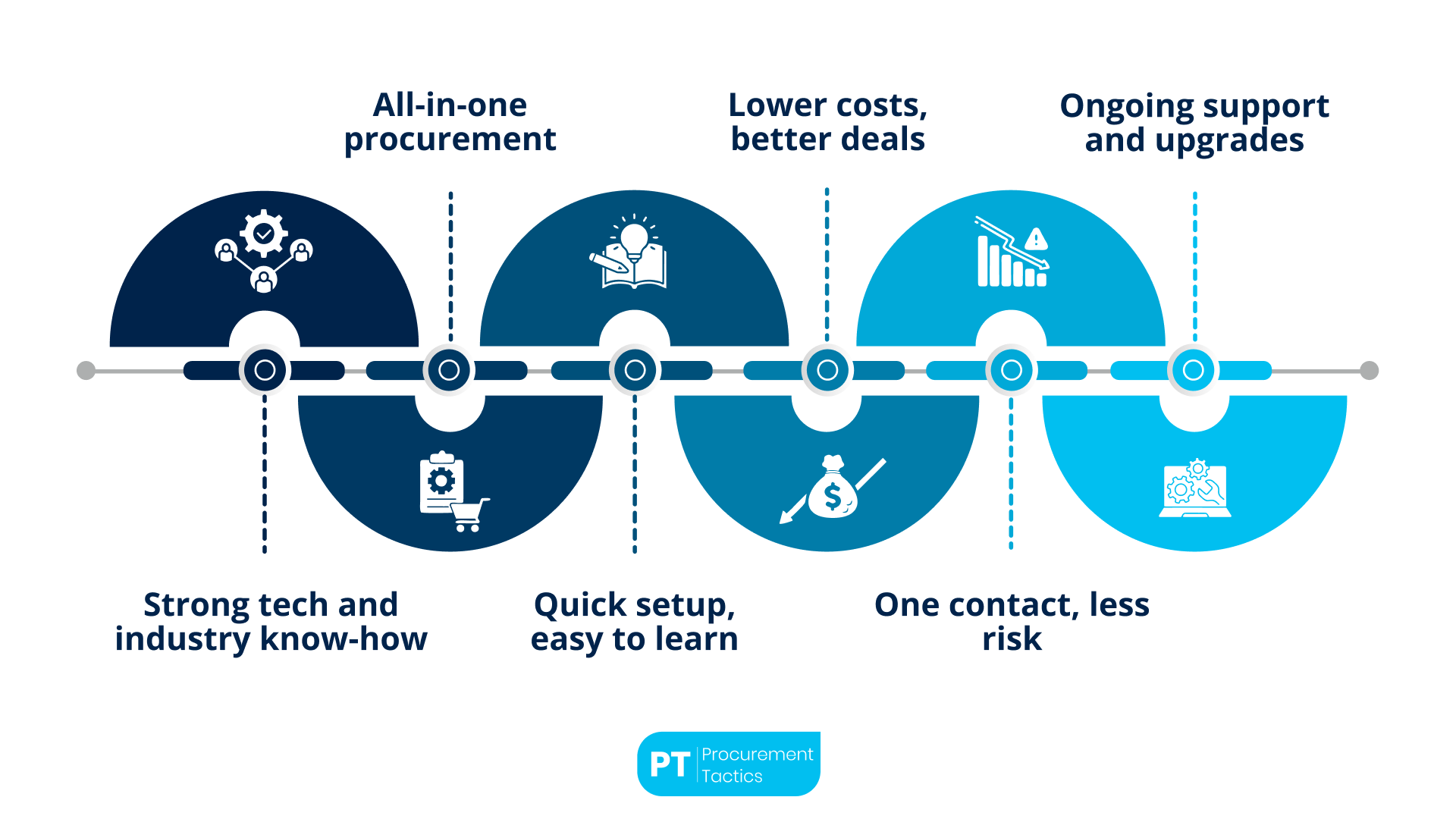Written by Marijn Overvest | Reviewed by Sjoerd Goedhart | Fact Checked by Ruud Emonds | Our editorial policy
What is VAR in Procurement? Explained + Examples
- A VAR in procurement is a supplier that resells hardware or software together with extra services like configuration, integration, and support.
- In a procurement context, a VAR serves as a one-stop partner that turns off-the-shelf products into ready-to-use solutions for the buyer.
- Put simply, VARs add value beyond the product itself—handling setup, training, and ongoing maintenance so the purchasing company does not need its own specialist team.
What is VAR in Procurement?
A Value-Added Reseller (VAR) in procurement is a supplier that resells products (most often software, hardware, or industrial equipment) in one integrated package that bundles installation, configuration, user training, and ongoing technical support.
Unlike a distributor, which primarily moves boxed products, or a systems integrator, which designs bespoke end-to-end architectures, a VAR focuses on enhancing an existing product with ready-made services that accelerate adoption and reduce risk.
For buyers, working with a VAR delivers a single point of accountability, streamlined contracting, and often a lower total cost of ownership (TCO) because software and services are priced as one bundle.
The flip side is that some VARs may favor vendors that yield higher margins or conflict with an organization’s preferred standards, so due diligence and transparent evaluation criteria remain essential.
What does a VAR Do?
A VAR buys products from the maker and turns them into a ready-to-use solution for the customer. It chooses the right hardware or software, installs it, moves any data, and teaches people how to use it. After setup, the VAR handles support, updates, and fixes, so the customer gets results fast without hiring their tech team.
Implementing VAR in Procurement – Examples
1. City of Mesa, Arizona – Master IT contract with CDW-G
To avoid running separate bids every time a department needed laptops or networking gear, the City of Mesa led a public-sector cooperative procurement and signed a five-year framework with CDW Government LLC.
The agreement covers the full catalogue of hardware, cloud subscriptions, and support services and is open to more than 45,000 U.S. public agencies; estimated annual spend is about US$ 500 million.
By funnelling purchases through a single value-added reseller, Mesa secures bulk-buy pricing, rebates for contract administration, and a single warranty/help-desk channel instead of dozens of vendor contracts.
2. Stockport NHS Foundation Trust – Hospital network modernization via CDW UK
Facing slow Wi-Fi and ageing PCs that were costing staff almost a million pounds a year in lost time, the Trust used CDW as its VAR to design, supply, and install a new wireless infrastructure and mobile-device estate.
CDW’s package bundled Cisco hardware, configuration services, and on-site roll-out, so procurement signed one contract rather than multiple supplier deals.
The upgrade now blankets every clinical area with reliable connectivity, lets clinicians work at the bedside, and has cut errors, security risks, and operating costs.
3. Arkansas BlueCross BlueShield – Cloud adoption through a CDW VAR engagement
When impending legislation meant the insurer had to scale quickly across state lines, its procurement team turned to CDW’s cloud practice instead of hiring its own architects.
CDW set up a Cloud Centre of Excellence, designed an Azure landing zone that met Microsoft best practices and governance requirements, and migrated workloads in stages.
A 45-day onboarding process was compressed to a few days, giving the business a secure, cost-controlled platform that can expand on demand and open new data analytics revenue streams.
4. US\$11 billion convenience-store chain – Insight Enterprises as a one-stop VAR
A national c-store retailer wanted to modernize everything from edge analytics on CCTV cameras to data protection and Azure migration.
Rather than running separate RFPs for each initiative, procurement signed a single services-plus-hardware agreement with Insight.
The VAR delivered consulting, managed services, and multi-vendor technology (Microsoft, Cisco, Lenovo, Cohesity, etc.), cutting ransomware exposure, boosting application performance, and giving headquarters real-time store analytics—all under one contract and support desk.
Benefits of Using a VAR in Procurement
Working with a VAR turns a complex purchasing project into a managed service. By bundling product sourcing with expert services, a VAR frees procurement teams to focus on strategy instead of integration headaches.
The advantages go well beyond simply getting a better price on hardware or software.

1. Deep technical and industry expertise
Leading VARs specialize in particular technologies or sectors, so they arrive already versed in best-practice architectures, regulatory nuances, and proven implementation templates. Their consulting insight helps buyers avoid trial-and-error experiments and select only the components that truly fit the brief.
2. One-stop, streamlined procurement.
Instead of juggling multiple suppliers, contracts, and delivery schedules, the buyer signs a single agreement covering both the products and the services that make them work. The VAR negotiates with manufacturers, consolidates shipping, clears customs where needed, and hands over a plug-and-play solution.
3. Faster deployment and a shorter learning curve
Because VAR engineers have already integrated similar solutions many times, they can configure, test, and go live far quicker than an in-house team learning on the job. Staff training, data migration, and workflow tweaks are folded into the rollout, so value starts flowing weeks—or months—sooner
4. Cost optimization and buying-power savings
VARs purchase in bulk and hold preferred-partner status with vendors, securing discounts that individual customers rarely obtain. Those savings, plus lower internal labor and rework costs, translate into a lower total cost of ownership over the system’s life.
5. Single point of contact and reduced contractual risk
When something breaks, there is “one neck to wring.” Support, warranty claims, and escalations all flow through the same team that built the solution, eliminating finger-pointing between software publishers and systems integrators and simplifying legal oversight.
6. Lifecycle support and future-proofing
A good VAR stays engaged after go-live: monitoring performance, applying patches, planning refresh cycles, and advising when emerging technologies can safely replace ageing equipment. That sustained partnership protects uptime and ensures the investment keeps pace with business needs.
Conclusion
A VAR turns off-the-shelf hardware or software into a turnkey solution by bundling selection, configuration, data migration, training, and long-term support under a single contract.
Because the VAR owns both the technology and the services, buyers gain one accountable partner, faster deployment, and often a lower total cost of ownership compared with piecemeal sourcing.
That convenience, however, comes with trade-offs: VARs may steer customers toward higher-margin vendors or architectures that clash with corporate standards. Procurement teams must therefore apply transparent evaluation criteria and ongoing performance reviews to keep the relationship objective and future-proof.
When managed well, a VAR partnership delivers deep technical expertise, streamlined purchasing, and lifecycle care, freeing procurement to focus on strategic priorities while still ensuring that the organization’s technology investments stay aligned with business goals.
Frequentlyasked questions
What is VAR in Procurement?
A VAR in procurement is a supplier that resells hardware or software together with extra services like configuration, integration, and support.
What Does a VAR Do in Procurement?
A VAR evaluates the buyer’s requirements, selects and procures the hardware or software, installs and integrates it, trains users, and then provides ongoing technical support—all within one consolidated contract.
Explain one Benefit of using VAR in Procurement.
A key benefit of using a VAR is that it gives procurement a single point of accountability for both products and services, which speeds deployment and often reduces total cost of ownership.
About the author
My name is Marijn Overvest, I’m the founder of Procurement Tactics. I have a deep passion for procurement, and I’ve upskilled over 200 procurement teams from all over the world. When I’m not working, I love running and cycling.






